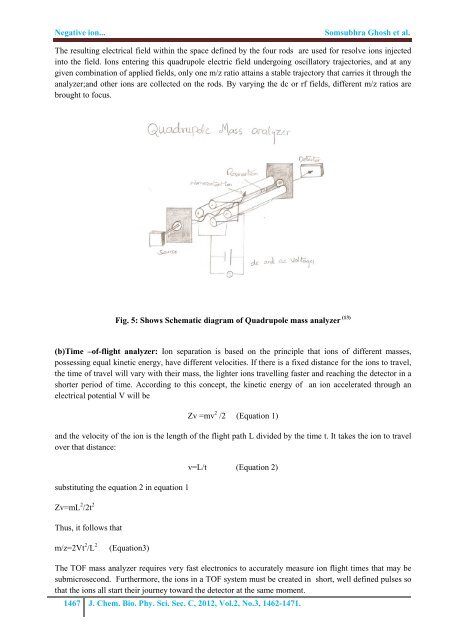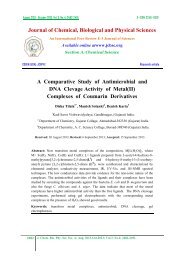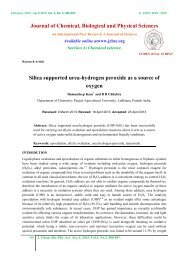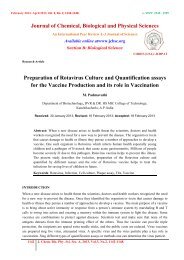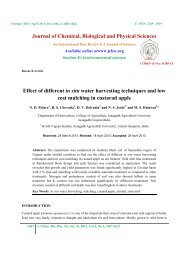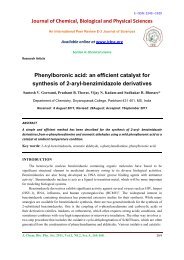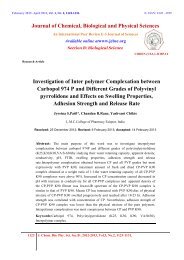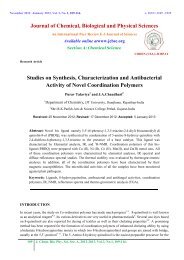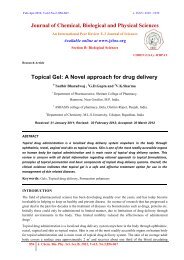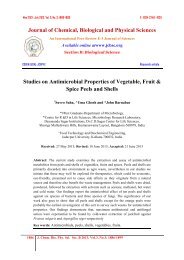Negative ion mode mass spectrometry - Journal of Chemical ...
Negative ion mode mass spectrometry - Journal of Chemical ...
Negative ion mode mass spectrometry - Journal of Chemical ...
Create successful ePaper yourself
Turn your PDF publications into a flip-book with our unique Google optimized e-Paper software.
<strong>Negative</strong> <strong>ion</strong>...Somsubhra Ghosh et al.The resulting electrical field within the space defined by the four rods are used for resolve <strong>ion</strong>s injectedinto the field. Ions entering this quadrupole electric field undergoing oscillatory trajectories, and at anygiven combinat<strong>ion</strong> <strong>of</strong> applied fields, only one m/z ratio attains a stable trajectory that carries it through theanalyzer;and other <strong>ion</strong>s are collected on the rods. By varying the dc or rf fields, different m/z ratios arebrought to focus.Fig. 5: Shows Schematic diagram <strong>of</strong> Quadrupole <strong>mass</strong> analyzer (13)(b)Time –<strong>of</strong>-flight analyzer: Ion separat<strong>ion</strong> is based on the principle that <strong>ion</strong>s <strong>of</strong> different <strong>mass</strong>es,possessing equal kinetic energy, have different velocities. If there is a fixed distance for the <strong>ion</strong>s to travel,the time <strong>of</strong> travel will vary with their <strong>mass</strong>, the lighter <strong>ion</strong>s travelling faster and reaching the detector in ashorter period <strong>of</strong> time. According to this concept, the kinetic energy <strong>of</strong> an <strong>ion</strong> accelerated through anelectrical potential V will beZv =mv 2 /2 (Equat<strong>ion</strong> 1)and the velocity <strong>of</strong> the <strong>ion</strong> is the length <strong>of</strong> the flight path L divided by the time t. It takes the <strong>ion</strong> to travelover that distance:substituting the equat<strong>ion</strong> 2 in equat<strong>ion</strong> 1Zv=mL 2 /2t 2Thus, it follows thatv=L/t (Equat<strong>ion</strong> 2)m/z=2Vt 2 /L 2(Equat<strong>ion</strong>3)The TOF <strong>mass</strong> analyzer requires very fast electronics to accurately measure <strong>ion</strong> flight times that may besubmicrosecond. Furthermore, the <strong>ion</strong>s in a TOF system must be created in short, well defined pulses sothat the <strong>ion</strong>s all start their journey toward the detector at the same moment.1467 J. Chem. Bio. Phy. Sci. Sec. C, 2012, Vol.2, No.3, 1462-1471.


